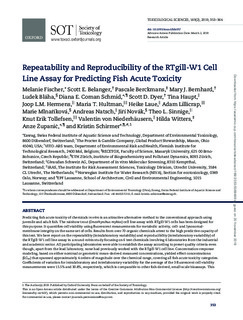| dc.contributor.author | Fischer, Melanie | |
| dc.contributor.author | Belanger, Scott E. | |
| dc.contributor.author | Berckmans, Pascale | |
| dc.contributor.author | Bernhard, Mary J. | |
| dc.contributor.author | Bláha, Ludek | |
| dc.contributor.author | Coman Schmid, Diana E. | |
| dc.contributor.author | Dyer, Scott D. | |
| dc.contributor.author | Haupt, Tina | |
| dc.contributor.author | Hermens, Joop L.M. | |
| dc.contributor.author | Hultman, Maria Thérése | |
| dc.contributor.author | Laue, Heike | |
| dc.contributor.author | Lillicrap, Adam David | |
| dc.contributor.author | Mlnaříková, Marie | |
| dc.contributor.author | Natsch, Andreas | |
| dc.contributor.author | Novák, Jirí | |
| dc.contributor.author | Sinnige, Theo L. | |
| dc.contributor.author | Tollefsen, Knut-Erik | |
| dc.contributor.author | Niederhäusern, Valentin von | |
| dc.contributor.author | Witters, Hilda | |
| dc.contributor.author | Zupanic, Anze | |
| dc.contributor.author | Schirmer, Kristin | |
| dc.date.accessioned | 2019-11-21T08:12:54Z | |
| dc.date.available | 2019-11-21T08:12:54Z | |
| dc.date.created | 2019-09-25T15:40:27Z | |
| dc.date.issued | 2019 | |
| dc.identifier.citation | Toxicological Sciences. 2019, 169 (2), 353-364. | nb_NO |
| dc.identifier.issn | 1096-6080 | |
| dc.identifier.uri | http://hdl.handle.net/11250/2629636 | |
| dc.description.abstract | Predicting fish acute toxicity of chemicals in vitro is an attractive alternative method to the conventional approach using juvenile and adult fish. The rainbow trout (Oncorhynchus mykiss) cell line assay with RTgill-W1 cells has been designed for this purpose. It quantifies cell viability using fluorescent measurements for metabolic activity, cell- and lysosomal-membrane integrity on the same set of cells. Results from over 70 organic chemicals attest to the high predictive capacity of this test. We here report on the repeatability (intralaboratory variability) and reproducibility (interlaboratory variability) of the RTgill-W1 cell line assay in a round-robin study focusing on 6 test chemicals involving 6 laboratories from the industrial and academic sector. All participating laboratories were able to establish the assay according to preset quality criteria even though, apart from the lead laboratory, none had previously worked with the RTgill-W1 cell line. Concentration-response modeling, based on either nominal or geometric mean-derived measured concentrations, yielded effect concentrations (EC50) that spanned approximately 4 orders of magnitude over the chemical range, covering all fish acute toxicity categories. Coefficients of variation for intralaboratory and interlaboratory variability for the average of the 3 fluorescent cell viability measurements were 15.5% and 30.8%, respectively, which is comparable to other fish-derived, small-scale bioassays. This study therefore underlines the robustness of the RTgill-W1 cell line assay and its accurate performance when carried out by operators in different laboratory settings. | nb_NO |
| dc.language.iso | eng | nb_NO |
| dc.publisher | Oxford University Press | nb_NO |
| dc.rights | Navngivelse-Ikkekommersiell 4.0 Internasjonal | * |
| dc.rights.uri | http://creativecommons.org/licenses/by-nc/4.0/deed.no | * |
| dc.title | Repeatability and reproducibility of the RTgill-W1 cell line assay for predicting fish acute toxicity | nb_NO |
| dc.type | Journal article | nb_NO |
| dc.type | Peer reviewed | nb_NO |
| dc.description.version | publishedVersion | nb_NO |
| dc.rights.holder | VC The Author(s) 2019 | nb_NO |
| dc.subject.nsi | VDP::Økotoksikologi: 489 | nb_NO |
| dc.subject.nsi | VDP::Eco-toxicology: 489 | nb_NO |
| dc.source.pagenumber | 353-364 | nb_NO |
| dc.source.volume | 169 | nb_NO |
| dc.source.journal | Toxicological Sciences | nb_NO |
| dc.source.issue | 2 | nb_NO |
| dc.identifier.doi | 10.1093/toxsci/kfz057 | |
| dc.identifier.cristin | 1729070 | |
| dc.relation.project | Norges forskningsråd: 196318 | nb_NO |
| cristin.unitcode | 7464,20,13,0 | |
| cristin.unitname | Økotoksikologi | |
| cristin.ispublished | true | |
| cristin.fulltext | original | |
| cristin.qualitycode | 2 | |

